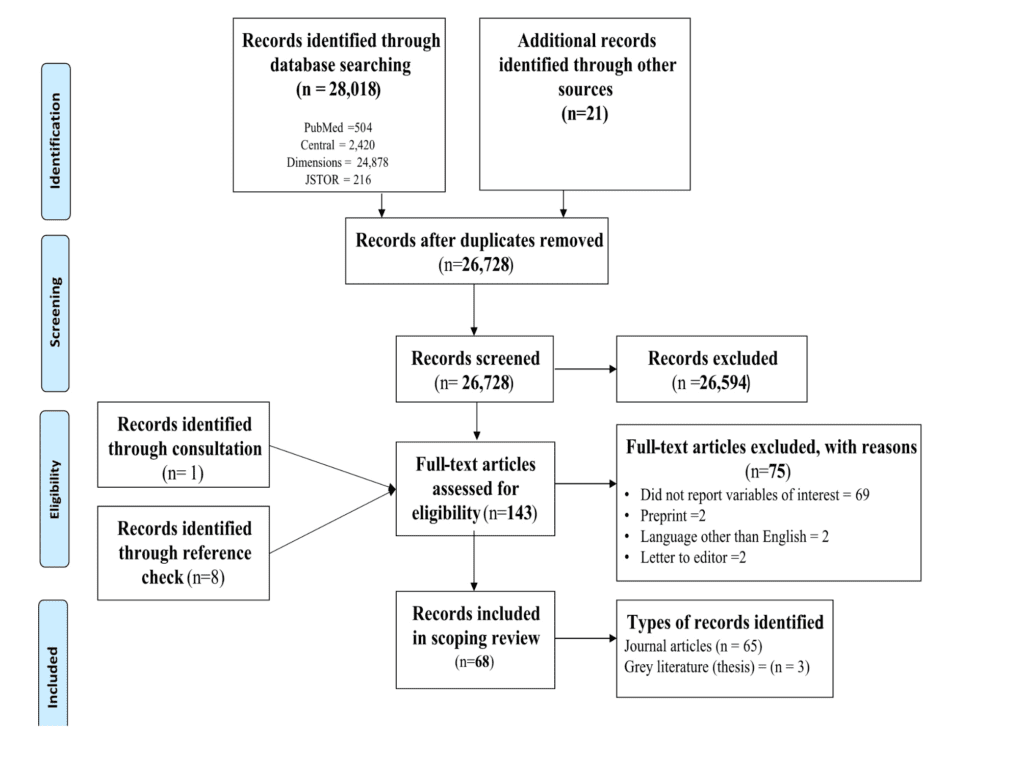Search Results
A search across four primary databases yielded a total of 28,018 records, in addition to another 21 records sourced from Google, Google Scholar, and institutional repositories, resulting in a cumulative total of 28,039 records. Utilizing Mendeley software, 1,311 duplicate entries were eliminated, leaving 26,728 records for further screening. After screening, abstracts and unrelated records were discarded, which narrowed the count to 134 full-text articles for in-depth evaluation. A review of the reference lists from these selected articles yielded an additional eight records, and one further record was acquired through consultation with Digital Librarian Dr. Kwame Kodua-Ntim. Consequently, a total of 143 records were evaluated for eligibility. Of these, 75 were excluded based on the established eligibility criteria presented in Table 1, while 68 records were retained for this review. Figure 1 illustrates the PRISMA flow diagram outlining the screening process. The majority of excluded studies lacked references to psychosocial work factors relevant to commercial drivers, hindering their inclusion. The exclusions did not stem from study appraisal, as none were assessed, and language barriers led to the rejection of two potentially valuable studies.
Characteristics of Reviewed Studies
The 68 studies included in the review were conducted across 32 different countries worldwide (see Fig. 2). The United States contributed the most studies with nine, followed by Taiwan with six and Ethiopia with four. Other nations like Brazil, Canada, Mexico, the Netherlands, Spain, and Sweden provided three studies each. Australia, China, Colombia, Japan, South Africa, and the United Kingdom accounted for two studies each, while numerous countries, including Argentina, Belgium, Chile, Denmark, Finland, Iran, Israel, Italy, New Zealand, Portugal, Saudi Arabia, Singapore, South Korea, Thailand, Turkey, Zambia, and Zimbabwe, contributed one study each. The data shows that cross-sectional surveys were the predominant research design, with 43 studies, followed by qualitative studies (eight), reviews and longitudinal designs (five each), while randomized controlled trials and mixed-method approaches each encompassed three studies. Experimental designs were least common, occurring in just one study, indicating a tendency towards observational and descriptive methodologies in the reviewed studies. The collective sampling involved 32,774 participants, including truck, taxi, bus, and other commercial drivers (refer to supplementary file, Table S1).
Psychosocial Work Factors of Commercial Drivers
The psychosocial factors impacting commercial drivers are categorized into three thematic areas: job design, organizational or workplace conditions, and work environment.
Job Design
In the context of commercial drivers, job design refers to the structuring of tasks and responsibilities to balance physical and mental job demands against supportive elements. Research indicates that commercial drivers frequently face high job demands, making them susceptible to fatigue and burnout. Evidence suggests that heavy physical workloads, extended driving hours, time pressures, social isolation, and role overload are detrimental to their health and overall well-being. Additionally, lengthy driving hours—surpassing eight hours daily and 40 hours weekly—are linked to significant health risks. However, one study involving Thai taxi drivers found no association between long daily driving hours and elevated haematocrit levels. Organizations that focus on health and well-being in job design may mitigate the adverse effects of demanding work conditions.
Organizational Conditions
Work conditions defining the experience of commercial drivers comprise the workplace environment and policies, which includes job security, management support, safety protocols, working hours, rest break scheduling, and access to necessary resources like healthcare and sanitation. Evidence suggests that when organizations prioritize profit over driver welfare, it correlates with poor health outcomes. Additionally, irregular schedules, inadequate rest opportunities, lack of vacation time, insufficient social protections like insurance, and poor safety culture expose drivers to numerous health challenges. The scarcity of sanitation and exercise facilities at transport hubs may lead to chronic illnesses among drivers operating on established routes.
Work Environment
The work environment for commercial drivers includes physical, social, and operational conditions they encounter, such as road quality, passenger interactions, and availability of rest stop facilities. Experiences of hostility from passengers and other drivers are commonly reported stressors. One qualitative study among Chilean commercial drivers identified confrontational behaviors from passengers as a primary stressor, and widespread incidents of conflict, violence, physical and verbal assault, and robbery pose substantial risks to drivers’ physical and mental health.
Psychosocial Working Conditions and Female Commercial Drivers
Three studies examined gender disparities in psychosocial work factors affecting commercial drivers. Findings indicated that while working conditions are often similar for both genders, female drivers face unique challenges that increase their difficulty in managing a hostile work setting. Two studies focusing exclusively on female drivers from Mexico and Southern Africa reported that long hours, lack of support, and work-family conflict contribute significantly to their health and safety challenges. Female drivers also encounter various forms of abuse and harassment in their workplace and have limited access to typical rest and hygiene facilities, resulting in precarious working conditions.
Psychosocial Work Factors of Truck Drivers
Specific psychosocial factors impacting truck drivers include irregular schedules characterized by extended hours, night shifts, and unpredictable working days which disrupt sleep patterns. Additionally, unrealistic expectations from employers can compel drivers to meet tight deadlines, increasing stress levels. Extended time away from home contributes to work-family conflict, and truck drivers often experience extreme fatigue and isolation, which can detrimentally affect their mental health.


